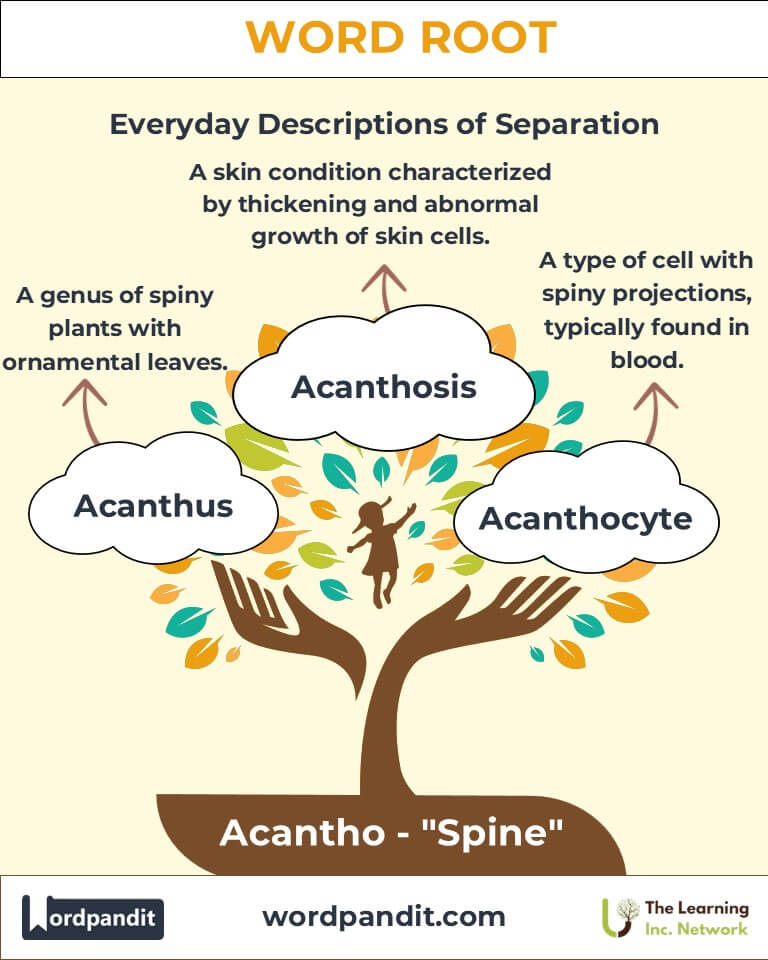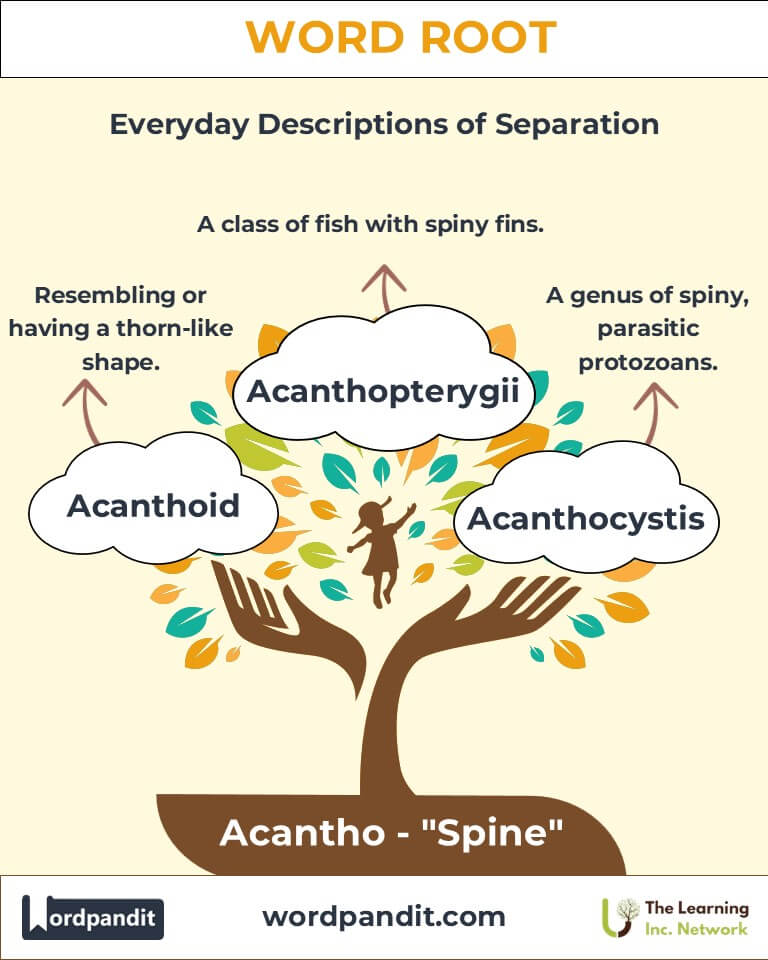Acantho: The Spiny Root in Biology and Beyond
Byline:
Explore the fascinating world of the root "acantho", derived from the Greek word for "spine" or "thorn." This root forms the foundation of terms like acanthoid (spine-like) and acanthocephala (thorny-headed worms), enriching the lexicon of biology, medicine, and natural sciences.

Table of Contents
- Introduction: The Essence of Acantho
- Etymology and Historical Journey
- Mnemonic: Unlocking the Power of Acantho
- Common Acantho-Related Terms
- Acantho Through Time
- Acantho in Specialized Fields
- Illustrative Story: Acantho in Action
- Cultural Significance of the Acantho Root
- The Acantho Family Tree
- FAQs about the Acantho Word Root
- Test Your Knowledge: Acantho Word Root Quiz
- Conclusion: The Enduring Significance of Acantho
1. Introduction: The Essence of Acantho
Imagine a world where the structures of organisms are defined by sharp edges and pointed features. The root acantho (pronounced ah-KAN-tho) originates from the Greek word akantha, meaning "spine" or "thorn." Whether describing spine-like projections in plants, animals, or microorganisms, acantho signifies resilience and defense. It serves as a cornerstone for biological and medical terminology, reflecting the importance of spiny structures in nature and their symbolic relevance across cultures.

2. Etymology and Historical Journey
The root acantho stems from the Greek akantha, historically used to describe thorns, spikes, and other pointed structures. Ancient botanists and anatomists incorporated the term into their observations, naming thorny plants and animals with spine-like adaptations. As biological sciences developed, acantho became essential in classifying organisms, such as Acanthocephala, a group of parasitic worms characterized by spiny appendages.
3. Mnemonic: Unlocking the Power of Acantho
Picture a thorny bush with branches forming the letters "ACANTHO." Imagine touching the spikes and thinking of the words "spine" and "thorn."
Mnemonic Device: "Acantho: Always Careful Around Nature's Thorny Obstacles."
4. Common Acantho-Related Terms
- Acanthoid (ah-KAN-thoid):
- Definition: Spine-like in shape.
- Example: "The acanthoid projections of the sea urchin help it defend against predators."
- Acanthocephala (ah-kan-tho-SEF-ah-lah):
- Definition: A phylum of parasitic worms with thorny heads used for attachment.
- Example: "The Acanthocephala species often inhabit the intestines of fish and birds."
- Acanthocyte (ah-KAN-tho-site):
- Definition: A red blood cell with irregular, spiny projections.
- Example: "Acanthocytes are commonly observed in blood smears of patients with liver disorders."
- Acanthoma (ah-KAN-tho-mah):
- Definition: A benign tumor derived from skin cells with spiny growths.
- Example: "The dermatologist diagnosed the small lesion as an acanthoma."
- Acanthaster (ah-kan-THAS-ter):
- Definition: A genus of starfish with spiny structures, commonly known as the crown-of-thorns starfish.
- Example: "The acanthaster is infamous for damaging coral reefs."
5. Acantho Through Time
- Acanthodians (Paleozoic Era): An extinct class of fish with spiny fins, considered evolutionary precursors to modern bony fishes.
- Modern Usage: Terms like acanthosis (skin thickening with spiny projections) reflect the root's continued relevance in medicine and dermatology.
6. Acantho in Specialized Fields
- Medicine:
- Acanthosis: Skin thickening characterized by darkened, spiny patches, often linked to insulin resistance.
- Zoology:
- Acanthocephala: Thorny-headed worms, crucial for understanding parasitology.
- Botany:
- Acanthus: A genus of flowering plants with spiny leaves, inspiring classical art and architecture.
- Marine Biology:
- Acanthaster: A spiny starfish threatening coral ecosystems.
7. Illustrative Story: Acantho in Action
Dr. Maya, a parasitologist, dedicated her career to studying Acanthocephala. During a field expedition, she discovered a new species in a freshwater fish. Naming it Acanthocephalus novae, she marveled at its thorny head—a perfect adaptation for anchoring inside its host. The discovery contributed to better understanding parasite-host interactions, with implications for both ecology and medicine.
8. Cultural Significance of the Acantho Root
The thorn has long been a symbol of protection and endurance in human culture. From the acanthus plant adorning Corinthian columns in ancient Greece to its role in heraldry and folklore, spiny structures have inspired awe and reverence. In modern times, acantho-based terms emphasize the intricate designs and adaptations of nature.

9. The Acantho Family Tree
- Spina (Latin: spine):
- Examples: Spinose – Full of spines or thorns; Spinal – Relating to the spine in anatomy.
- Thorn (Old English):
- Example: Thorny – Covered in or resembling thorns.
- Dermato (Greek: skin):
- Examples: Dermatitis – Inflammation of the skin; Acanthoma – A skin lesion with thorn-like structures.

10. FAQs About " Acantho "
Q: What does "acantho" mean, and where does it originate?
A: Acantho means "spine" or "thorn," derived from the Greek word akantha. It is commonly used in biology to describe spiny or thorn-like structures in plants, animals, and even cells. The term reflects nature's adaptations for defense, attachment, or other purposes.
Q: What are acanthocephalans, and why are they significant?
A: Acanthocephalans are a group of parasitic worms, also known as thorny-headed worms. They use their spiny proboscis to attach to the intestinal walls of their hosts, which include fish, birds, and mammals. Their unique morphology and parasitic behavior are essential in understanding host-parasite interactions and managing infections in ecosystems and animal health.
Q: What is an acanthocyte, and in what conditions is it observed?
A: An acanthocyte is a type of red blood cell characterized by irregular, spiny projections. These cells are often seen in blood smears of patients with certain medical conditions, such as liver disease, neuroacanthocytosis, or abetalipoproteinemia. Their presence can help diagnose underlying systemic diseases.
Q: Are all acantho-related terms biological in nature?
A: No, while most acantho-related terms are rooted in biology, they also appear in art and architecture. For example, acanthus refers to a plant with spiny leaves that inspired classical decorative designs, particularly in Corinthian columns.
Q: How does "acantho" relate to dermatology?
A: In dermatology, terms like acanthoma (a benign tumor with spiny projections) and acanthosis (thickened skin with thorn-like structures) are derived from acantho. These terms describe specific skin conditions that aid in diagnosis and treatment.
11. Test Your Knowledge: " Acantho " Mastery Quiz
1. What does "acantho" signify?
2. Which term refers to thorny-headed worms?
3. What does an acanthocyte describe?
4. Where would you find an acanthaster?
5. What does "acanthoid" mean?
12. Conclusion: The Enduring Significance of Acantho
The root acantho serves as a linguistic reminder of nature’s resilience and adaptability. From thorny plants to spiny marine creatures, it captures the essence of defense and survival. As scientific discovery progresses, acantho-related terms will continue to illuminate the intricate designs of life, enriching our understanding of biology and beyond.












